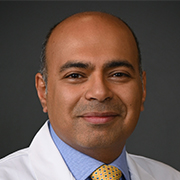
Magdi H. Awad, PharmD, MSA (mawad@neomed.edu) is a professor of pharmacy practice at Northeast Ohio Medical University (NEOMED) and the founding director of pharmacy at AxessPointe, a federally qualified health center with seven locations in northeast Ohio. His responsibilities at AxessPointe include expanding the clinical pharmacy services, overseeing the onsite community and specialty pharmacies, and precepting the pharmacy residents and students at AxessPointe. Magdi’s expertise is in primary care services, pharmacy administration, and the 340B pricing program. Magdi received his Doctor of Pharmacy and residency training at the University of Minnesota. He completed a fellowship in academic medicine and received his Master of Science in Pharmacy Administration at NEOMED.
Magdi has served ASHP on multiple Section Advisory Groups (SAGs) for the Section of Community Pharmacy Practitioners. He currently serves as vice chair of the SAG on Patient Care. He has been a frequent reviewer for AJHP since 2018 and has co-authored multiple documents on ASHP’s Ambulatory Care and Community Pharmacy Resource Centers.
Magdi was the Chair of the Ohio Medication Therapy Management Consortium, sponsored by the Ohio Department of Health. He is a founding student organization advisor to the Student Run Free Clinic on campus. Magdi has received multiple awards and recognitions, including the ASHP’s Pharmacy Champion Award, Akron’s 30 for the Future Award, NEOMED’s Distinguished Alumni Award and Dean’s Leadership Award, the Most Influential Faculty Award, and Crain’s Business Who to Watch in Healthcare.
Community pharmacies have the potential to provide needed primary care and prevention services and to alleviate disparity and medication access issues. Yet, we are facing many hindering challenges. Besides staffing concerns, significant challenges arise from the inadequate reimbursement and anticompetitive practices deployed by many pharmacy benefit managers (PBMs). As many governmental entities and legislative bodies are investigating PBMs, the time is now to expose their practices and advocate for patients’ choice of pharmacy provider and for reimbursement and contracting transparency. I look forward to a strong advocacy campaign that includes ASHP and other interested organizations to explain the dire situation, its impact on patient care, and the potential solutions.
On a positive note, I applaud the section’s efforts to define the significant role of community pharmacy practitioners and to showcase innovative practices and opportunities to maximize that role. Over the past few years, the section has produced many valuable resources, thanks to its engaged and committed members. With this energetic involvement, we are poised to continue to reimagine our role as community pharmacy practitioners to meet the needs of our patients and communities.
With the collective skills and experiences in our section, I feel very strongly about the section’s ability to greatly impact community pharmacies. To that extent, I will bring to the section my experience in establishing and integrating both clinical and dispensing services at my organization and my advocacy experience in Ohio, including expanding our scope of practice, provider status, enhanced reimbursement, and 340B protections.
